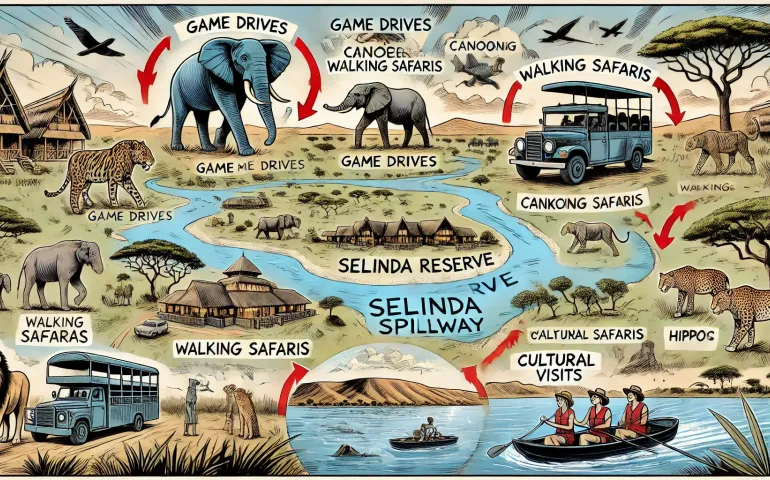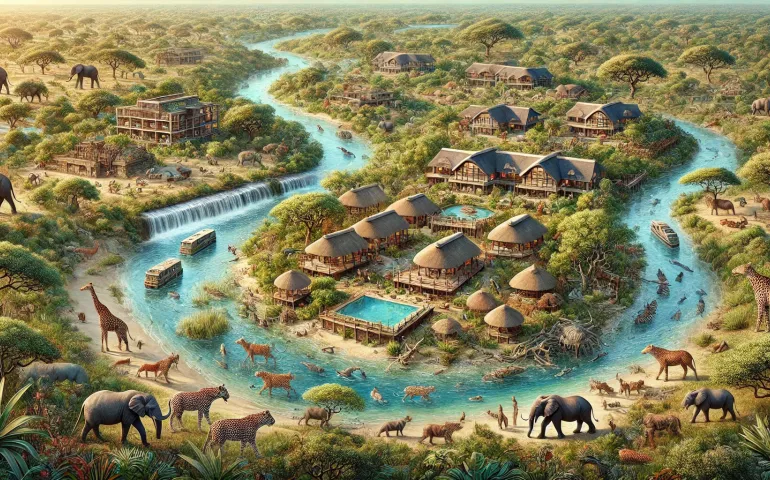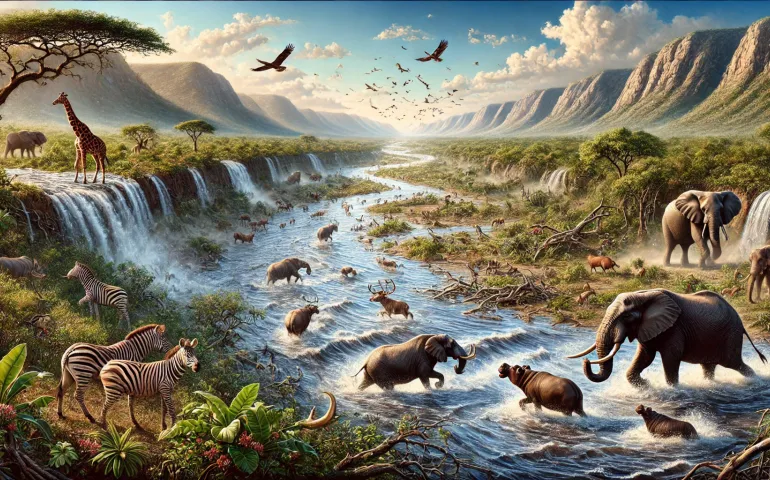About Place
- “An untouched wilderness where the spirit of Africa comes alive.”
- “A wildlife paradise offering an intimate connection with nature.”
- “Remote and tranquil, a haven for luxury safaris and adventurous souls.”
Reasons to Visit
- Exclusive Safari Experience: Selinda Reserve, located in northern Botswana, offers one of Africa’s most exclusive and intimate safari experiences. This 320,000-acre private wildlife sanctuary is a gem in the conservation world, renowned for its diverse ecosystems. The reserve is home to a vast array of wildlife, including elephants, lions, leopards, cheetahs, and a variety of bird species. The Selinda Spillway, a waterway linking the Okavango Delta to the Linyanti Marshes, adds a unique aquatic dimension to the safari experience, attracting hippos and crocodiles.
- Pristine Wilderness: Selinda is celebrated for its unspoiled landscapes and low tourist density, making it a perfect destination for those seeking solitude and a true wilderness experience. The reserve's commitment to conservation ensures the environment remains largely untouched, providing a sanctuary for both wildlife and visitors. This pristine setting offers a raw, authentic connection with nature that is hard to find in more commercialized safari destinations.
- Luxurious Yet Eco-friendly Lodges: The lodges in Selinda Reserve, such as Selinda Explorers Camp and Selinda Camp, offer luxury accommodations that seamlessly blend comfort with environmental sustainability. Guests can enjoy plush amenities and gourmet dining while knowing that their stay supports conservation efforts. These lodges often feature activities like guided walking safaris, canoeing, and game drives led by expert guides, ensuring an immersive and educational experience.
Visa
- United States, Canada, European Union, United Kingdom, and Australia: Visa-free for stays up to 90 days.
- India, China, and other countries: Visa required; application can be done online or at a Botswana embassy.
- South Africa: Visa-free for stays up to 90 days.
Travel Expenses
1. Travel to & from destination:
- Charter flight from Maun to Selinda Reserve: $600 per person (round trip).
- Total for a couple: $1,200.
2. Hotel cost:
- Selinda Camp: $1,200 per night (all-inclusive).
- Total for 3 nights: $3,600 for a couple.
3. Food cost:
- Included in the all-inclusive lodge stay.
4. Activity cost:
- Included in the all-inclusive lodge stay.
5. Near destination travel cost:
- Included in the all-inclusive lodge stay.
Total estimated cost for a couple: $4,800.

Best Itinerary
Day 1: Arrival and Relaxation Arrive in Maun, Botswana, and take a charter flight to Selinda Reserve. Check into Selinda Camp by early afternoon. Spend the rest of the day relaxing and acclimating to the surroundings. Enjoy a late afternoon game drive from 4:00 PM to 7:00 PM, where you might spot elephants and lions. Dinner will be served at the camp's dining area, featuring local Botswana cuisine such as seswaa (slow-cooked beef) and morogo (wild spinach).
Day 2: Morning Safari and Canoeing Start the day with a sunrise game drive from 6:00 AM to 9:00 AM, witnessing the morning activities of the wildlife. Return for breakfast at the lodge. From 11:00 AM to 1:00 PM, enjoy a guided canoeing adventure on the Selinda Spillway, providing a unique perspective of the landscape and its inhabitants. Lunch will be a picnic by the spillway, featuring fresh salads, grilled meats, and local fruits. In the evening, from 4:00 PM to 7:00 PM, take another game drive focusing on predators. Dinner at the camp will include a selection of grilled meats and vegetables.
Day 3: Walking Safari and Cultural Visit Begin with a walking safari from 6:00 AM to 9:00 AM, allowing you to track wildlife and learn about smaller flora and fauna. After breakfast, visit a nearby local village from 11:00 AM to 1:00 PM to learn about the culture and traditions of the indigenous people. Lunch will be at the lodge, featuring dishes like chicken in peanut sauce and pap (maize porridge). Spend the afternoon relaxing or enjoying the camp's pool. An evening game drive from 4:00 PM to 7:00 PM will round off the day, followed by a traditional Botswanan dinner with performances by local musicians.
Day 4: Departure Enjoy a final early morning game drive from 6:00 AM to 9:00 AM before breakfast. Prepare for departure, taking the charter flight back to Maun by mid-morning.

Safety Tips
- Always listen to your safari guide's instructions.
- Keep a safe distance from wildlife.
- Wear neutral-colored clothing during safaris.
- Stay hydrated and use sunscreen.
- Avoid walking alone at night in the reserve.
- Keep your tent zipped and secure.
- Do not leave food unattended in your tent.
- Carry a basic first aid kit.
- Be aware of your surroundings at all times.
- Respect local customs and traditions.
Flights
- From Johannesburg (JNB) to Maun (MUB): Air Botswana, 1.5 hours, approx. $400 per person round trip.
- Charter flight from Maun to Selinda Reserve: $600 per person round trip.
Hotels
- Selinda Camp
- Selinda Explorers Camp
- Zarafa Camp
- Duba Plains Camp
- King’s Pool Camp
Contacts
- Indian Embassy in Botswana: +267 391 2525
- Police: 999
- Ambulance: 997
- Firefighters: 998
Country
Closet Airport
- Maun Airport (MUB)
Nearest City
- Maun
Heritage Sites
None officially designated, but the reserve itself is a conservation area of significant ecological importance.
Airlines
- Air Botswana
- South African Airways
Currency
- Botswana Pula (BWP)
Languages Spoken
- Setswana
- English
Real Story
The Rebirth of the Selinda Spillway
The Selinda Spillway, a waterway linking the Okavango Delta to the Linyanti Marshes, has a fascinating history marked by dramatic changes in its flow patterns. For decades, this vital lifeline remained dry, reducing the area’s capacity to support its diverse wildlife populations. However, in 2009, an extraordinary natural event occurred that changed the fate of Selinda Reserve and its inhabitants.
In the late 2000s, Botswana experienced a series of unusually heavy rains and significant flooding in the Okavango Delta. These rains were part of a broader climatic pattern affecting the region. As a result, the waters of the Okavango Delta began to surge northward, seeking new paths to drain. The Selinda Spillway, which had been dry for over three decades, began to fill once again.
The re-flooding of the spillway was a remarkable sight. Water slowly crept along the dry riverbed, transforming the landscape and rejuvenating the ecosystem. The spillway, which stretches for about 80 kilometers, became a bustling waterway teeming with life. Aquatic plants thrived, fish populations increased, and large animals like hippos and crocodiles returned to their ancient habitat.
This natural revival had a profound impact on the entire Selinda Reserve. The abundance of water attracted a variety of wildlife, including elephants, buffalo, and antelope, which flocked to the spillway for sustenance. Predators like lions and leopards also followed, drawn by the increased prey populations. Bird species, too, flourished in the revitalized wetlands, making Selinda a birdwatcher's paradise.
The resurgence of the Selinda Spillway is not just an ecological miracle but also a symbol of nature’s resilience and adaptability. It highlights the dynamic and ever-changing nature of ecosystems, and the importance of preserving such habitats to allow these natural processes to occur. The event underscored the success of Botswana’s conservation efforts, which prioritize protecting and restoring natural environments.
For visitors to Selinda Reserve, the spillway’s rebirth offers a unique opportunity to witness a thriving ecosystem that stands as a testament to the power of natural restoration. Guided canoeing expeditions on the spillway allow guests to explore the rich biodiversity up close, while game drives along its banks provide stunning views of the wildlife that depend on this vital water source. The story of the Selinda Spillway is a compelling reminder of the intricate connections within nature and the importance of conservation.
Cuisine
Botswana’s cuisine is a delightful blend of traditional flavors and locally sourced ingredients, offering visitors a unique culinary experience. In Selinda Reserve, the food reflects the rich cultural heritage of Botswana, with dishes that are both simple and flavorful. Here are some highlights:
Seswaa: Seswaa is a traditional dish made from slow-cooked, shredded beef. The meat is typically cooked with a bit of salt and water until it is tender and can be easily pulled apart. It is often served with pap (a type of maize porridge) or bogobe (sorghum porridge), making it a hearty and satisfying meal. This dish is a staple in Botswanan cuisine and provides a taste of the local culinary traditions.
Morogo: Morogo refers to a variety of wild spinach or leafy greens that are commonly eaten in Botswana. These greens are usually boiled and then sautéed with onions and tomatoes. Sometimes, they are mixed with groundnuts (peanuts) to add a nutty flavor and extra nutrition. Morogo is a healthy and flavorful side dish that accompanies many main courses.
Phane: Phane, or mopane worms, are a traditional delicacy in Botswana. These caterpillars are harvested from mopane trees and are either dried or cooked fresh. When dried, they are rehydrated and cooked with tomatoes, onions, and spices. They are high in protein and are considered a nutritious snack or meal component. For adventurous eaters, trying phane is a must to fully experience the local cuisine.
Grilled Meats: Botswana is known for its high-quality beef and other meats, which are often grilled to perfection. Visitors can enjoy a variety of grilled meats, including beef steaks, lamb chops, and game meat like kudu or impala. These meats are typically marinated with local spices and served with side dishes like roasted vegetables or maize meal.
Traditional Drinks: The local drink scene includes homemade beverages like ginger beer and bogobe jwa lerotse, a fermented melon drink. These drinks offer a refreshing taste and are often enjoyed during meals or social gatherings.
In Selinda Reserve, the lodges and camps often incorporate these traditional dishes into their menus, providing guests with an authentic taste of Botswana’s culinary heritage. Meals are typically served in communal dining areas, allowing guests to share stories and experiences while enjoying delicious food in a stunning natural setting.

Culture and History
Selinda Reserve, located in northern Botswana, is not only a natural paradise but also a reflection of the rich cultural heritage of Botswana. The area is deeply influenced by the traditions and customs of the local communities, predominantly the Tswana people. Here are some key aspects of the culture and history of Selinda Reserve:
Traditional Lifestyle: The Tswana people have historically lived in harmony with nature, relying on the land and its resources for their sustenance. This close connection to the environment is evident in their customs, food, and daily practices. Traditional homesteads, often circular in shape and made from natural materials like mud and thatch, dot the landscape, showcasing a way of life that has remained relatively unchanged for generations.
Music and Dance: Music and dance play a vital role in the cultural expression of the Tswana people. Traditional instruments like the segaba (a single-stringed violin) and drums are commonly used in celebrations and rituals. Dance styles such as the borankana, a communal dance performed in a circle, and the more modern gumboot dance, which originated in the mines of South Africa, are integral to cultural festivities. These performances often tell stories of historical events, daily life, and the relationship between humans and wildlife.
Storytelling: Oral traditions are a cornerstone of Tswana culture. Elders pass down stories, myths, and legends to younger generations, preserving the community's history and values. These stories often feature animals and natural elements, reflecting the deep-seated respect for the environment. Visitors to Selinda Reserve may have the opportunity to listen to these tales, gaining insight into the local worldview.
Conservation Ethos: The cultural landscape of Selinda is heavily influenced by its commitment to conservation. The reserve is a model for sustainable tourism and wildlife management, emphasizing the protection of natural habitats and species. This ethos is shared by the local communities, who see the benefits of preserving their environment not just for ecological reasons, but also for maintaining their cultural heritage and livelihood through eco-tourism.
Historical Context: Botswana has a history of peaceful coexistence and political stability, which has fostered a strong national identity and pride. The country's history of conservation began in the 1960s, with efforts to protect endangered species and habitats. The establishment of Selinda Reserve is part of this broader conservation movement, aimed at safeguarding Botswana's natural treasures for future generations.
